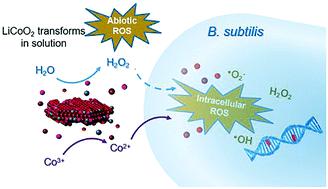当前位置:
X-MOL 学术
›
Environ. Sci.: Nano
›
论文详情
Our official English website, www.x-mol.net, welcomes your feedback! (Note: you will need to create a separate account there.)
Dynamic aqueous transformations of lithium cobalt oxide nanoparticle induce distinct oxidative stress responses of B. subtilis
Environmental Science: Nano ( IF 7.3 ) Pub Date : 2021-4-28 , DOI: 10.1039/d0en01151g Metti K. Gari 1, 2, 3, 4 , Paul Lemke 1, 2, 3, 4 , Kelly H. Lu 1, 2, 3, 4 , Elizabeth D. Laudadio 4, 5, 6, 7 , Austin H. Henke 4, 5, 6, 7 , Curtis M. Green 4, 5, 6, 7 , Thomas Pho 1, 2, 3, 4 , Khoi Nguyen L. Hoang 4, 5, 8, 9 , Catherine J. Murphy 4, 5, 8, 9 , Robert J. Hamers 4, 5, 6, 7 , Z. Vivian Feng 1, 2, 3, 4
Environmental Science: Nano ( IF 7.3 ) Pub Date : 2021-4-28 , DOI: 10.1039/d0en01151g Metti K. Gari 1, 2, 3, 4 , Paul Lemke 1, 2, 3, 4 , Kelly H. Lu 1, 2, 3, 4 , Elizabeth D. Laudadio 4, 5, 6, 7 , Austin H. Henke 4, 5, 6, 7 , Curtis M. Green 4, 5, 6, 7 , Thomas Pho 1, 2, 3, 4 , Khoi Nguyen L. Hoang 4, 5, 8, 9 , Catherine J. Murphy 4, 5, 8, 9 , Robert J. Hamers 4, 5, 6, 7 , Z. Vivian Feng 1, 2, 3, 4
Affiliation

|
Lithium cobalt oxide (LiCoO2), an example of nanoscale transition metal oxide and a widely commercialized cathode material in lithium ion batteries, has been shown to induce oxidative stress and generate intracellular reactive oxygen species (ROS) in model organisms. In this study, we aimed to understand the time-dependent roles of abiotic ROS generation and Co ions released in aqueous medium by LiCoO2 NPs, and examined the induced biological responses in model bacterium, B. subtilis upon exposure. We found that the redox-active LiCoO2 NPs produced abiotic ROS primarily through H2O2 generation when freshly suspended. Subsequently, the freshly-suspended LiCoO2 NPs induced additional DNA breakage, and changes in expression of oxidative stress genes in B. subtilis that could not be accounted for by the released Co ions alone. Notably, in 48 hour old LiCoO2 suspensions, H2O2 generation subsided while higher concentrations of Co ions were released. The biological responses in DNA damage and gene expression to the aged LiCoO2 NPs recapitulated those induced by the released Co ions. Our results demonstrated oxidative stress mechanisms for bacteria exposed to LiCoO2 NPs were mediated by the generation of distinct biotic and abiotic ROS species, which depended on the aqueous transformation state of the NPs. This study revealed the interdependent and dynamic nature of NP transformation and their biological consequences where the state of NPs resulted in distinct NP-specific mechanisms of oxidative injury. Our work highlights the need to capture the dynamic transformation of NPs that may activate the multiple routes of oxidative stress responses in cells.
中文翻译:

锂钴氧化物纳米粒子的动态水相转变引起枯草芽孢杆菌独特的氧化应激反应
锂钴氧化物(LiCoO 2)是纳米级过渡金属氧化物的一个例子,是锂离子电池中广泛使用的阴极材料,已显示出可诱导氧化应激并在模型生物中产生细胞内活性氧(ROS)。在这项研究中,我们旨在了解LiCoO 2 NPs在水介质中释放的非生物ROS生成和Co离子的时间依赖性作用,并研究了暴露于模型细菌枯草芽孢杆菌中的诱导生物反应。我们发现,当新鲜悬浮时,具有氧化还原活性的LiCoO 2 NP主要通过H 2 O 2的产生而产生非生物活性氧。随后,新悬浮的LiCoO 2NPs引起额外的DNA断裂,以及枯草芽孢杆菌中氧化应激基因表达的变化,这仅是由释放的Co离子无法解释的。值得注意的是,在48小时的LiCoO 2悬浮液中,H 2 O 2的生成减少,而释放出更高浓度的Co离子。DNA损伤和基因表达对衰老的LiCoO 2 NPs的生物学响应概括了由释放的Co离子诱导的响应。我们的结果证明了暴露于LiCoO 2的细菌的氧化应激机制NPs是由不同的生物和非生物ROS物种的产生介导的,这取决于NPs的水相转化状态。这项研究揭示了NP转化的相互依赖和动态性质,以及它们的生物学后果,其中NP的状态导致不同的NP特异性氧化损伤机制。我们的工作强调需要捕获NP的动态转化,该动态转化可能激活细胞中氧化应激反应的多种途径。
更新日期:2021-05-04
中文翻译:

锂钴氧化物纳米粒子的动态水相转变引起枯草芽孢杆菌独特的氧化应激反应
锂钴氧化物(LiCoO 2)是纳米级过渡金属氧化物的一个例子,是锂离子电池中广泛使用的阴极材料,已显示出可诱导氧化应激并在模型生物中产生细胞内活性氧(ROS)。在这项研究中,我们旨在了解LiCoO 2 NPs在水介质中释放的非生物ROS生成和Co离子的时间依赖性作用,并研究了暴露于模型细菌枯草芽孢杆菌中的诱导生物反应。我们发现,当新鲜悬浮时,具有氧化还原活性的LiCoO 2 NP主要通过H 2 O 2的产生而产生非生物活性氧。随后,新悬浮的LiCoO 2NPs引起额外的DNA断裂,以及枯草芽孢杆菌中氧化应激基因表达的变化,这仅是由释放的Co离子无法解释的。值得注意的是,在48小时的LiCoO 2悬浮液中,H 2 O 2的生成减少,而释放出更高浓度的Co离子。DNA损伤和基因表达对衰老的LiCoO 2 NPs的生物学响应概括了由释放的Co离子诱导的响应。我们的结果证明了暴露于LiCoO 2的细菌的氧化应激机制NPs是由不同的生物和非生物ROS物种的产生介导的,这取决于NPs的水相转化状态。这项研究揭示了NP转化的相互依赖和动态性质,以及它们的生物学后果,其中NP的状态导致不同的NP特异性氧化损伤机制。我们的工作强调需要捕获NP的动态转化,该动态转化可能激活细胞中氧化应激反应的多种途径。


























 京公网安备 11010802027423号
京公网安备 11010802027423号